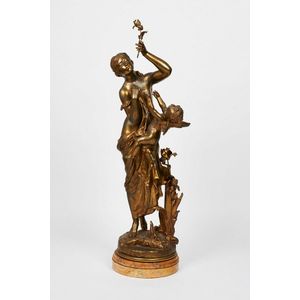Ormolu and Bronze Chenets with Dragon Mounts
You must be a subscriber, and be logged in to view price and dealer details.
Subscribe Now to view actual auction price for this item
When you subscribe, you have the option of setting the currency in which to display prices to $Au, $US, $NZ or Stg.
- Chenets - Cenets are the French name for fire dogs or andirons. They are metal supports for logs in the fireplace, usually with two feet at the front and one at the back. They hold the wood above the hearth level allowing the air to pass around it to facilitate burning. Until the beginning of the 15th century they were made of wrought iron, and after this date were made in cast iron or steel, often with decorative brass embellishments.
- Bronze - An alloy of copper and tin, traditionally in the proportions of about 9 parts of copper to 1 part of tin.
The discovery of bronze in Western Asia in the 4th century enabled people to create metal objects which were superior to those previoulsy possible because of its strength and hardness, and it has been used throughout the world for weapons, coins, tools, statuary and other decorative items.
It is very fluid in a molten state, and its hardness, strength when set, and non-corrosive properties makes it most suitable for casting sculpture. - Ormolu - Ormolu was popular with French craftsmen in the 18th and 19th century for ornamental fittings for furniture, clocks and other decorative items. True ormolu is gilt bronze, that is bronze that has been coated with gold using a mercury amalgam. Due to the health risks associated with using mercury, this method of creating ormolu was discontinued in France in the 1830s. A substitute was developed consisting of about 75% copper and 25% zinc, however it was inferior to the bronze version. It was often lacquered to prevent it tarnishing.
- Acanthus - A stylized leaf motif, one of the primary decorative elements of classical Greek and Roman architecture, derived from the genus of flowering plants in the family Acanthaceae, native to tropical and subtropical regions of the Mediterranean area. It is a common element in classical Greek and Roman design, and is often seen in Corinthian and Composite order columns and used as a decorative element in English, European and Australian furniture, particularly on the curve of a leg, and as decoration for a corbel.
This item has been included into following indexes:
Visually similar items

19th century French rococo style table mirror, set with a central shaped mirror, surrounded by s and c-scrolls

A.D. Mougin bronze & onyx clock garniture height 72 cm

An antique French style small table top vitrine, burr walnut with fancy ormolu mounts, serpentine form, shaped glass panel front and sides, door to the back, raised on scrolling ormolu legs. 30 x 18 x 60.5 cm

After Mathurin Moreau (French, 1822-1912), cast gilt metal sculpture of Venus and Cupid, signed, on round marble base, height 93 cm
